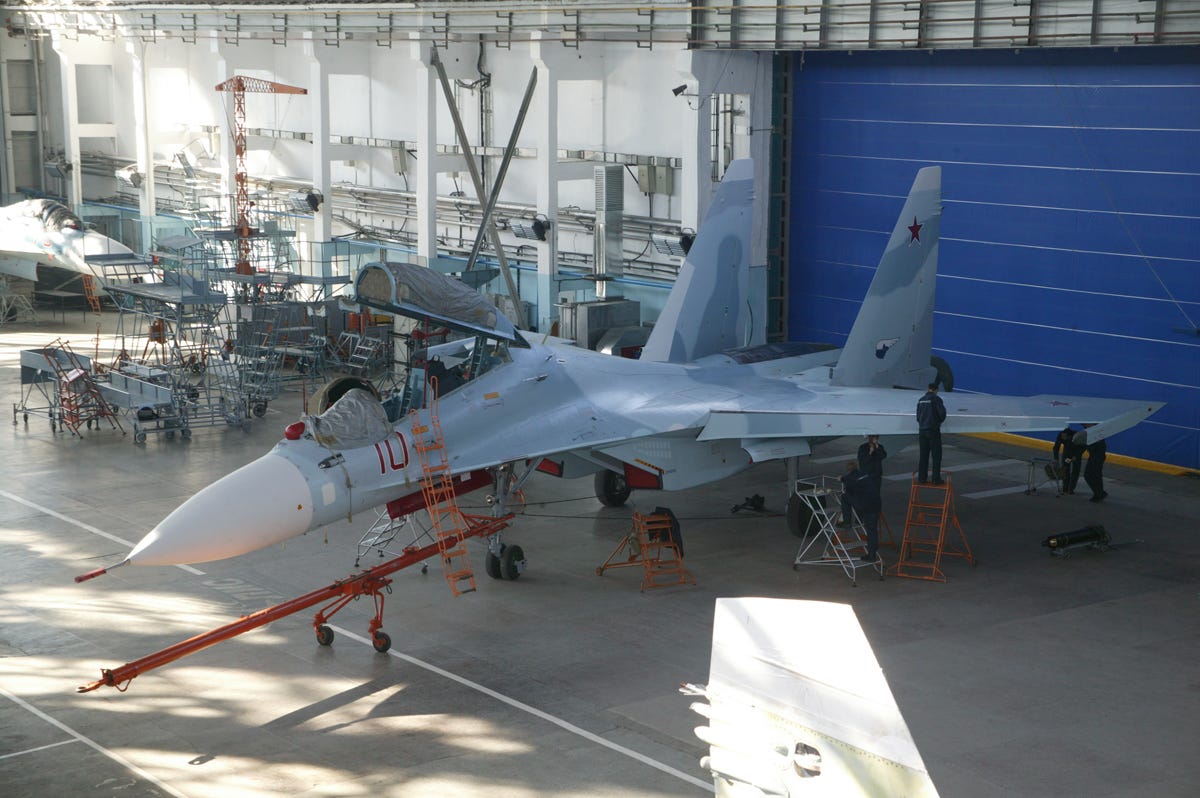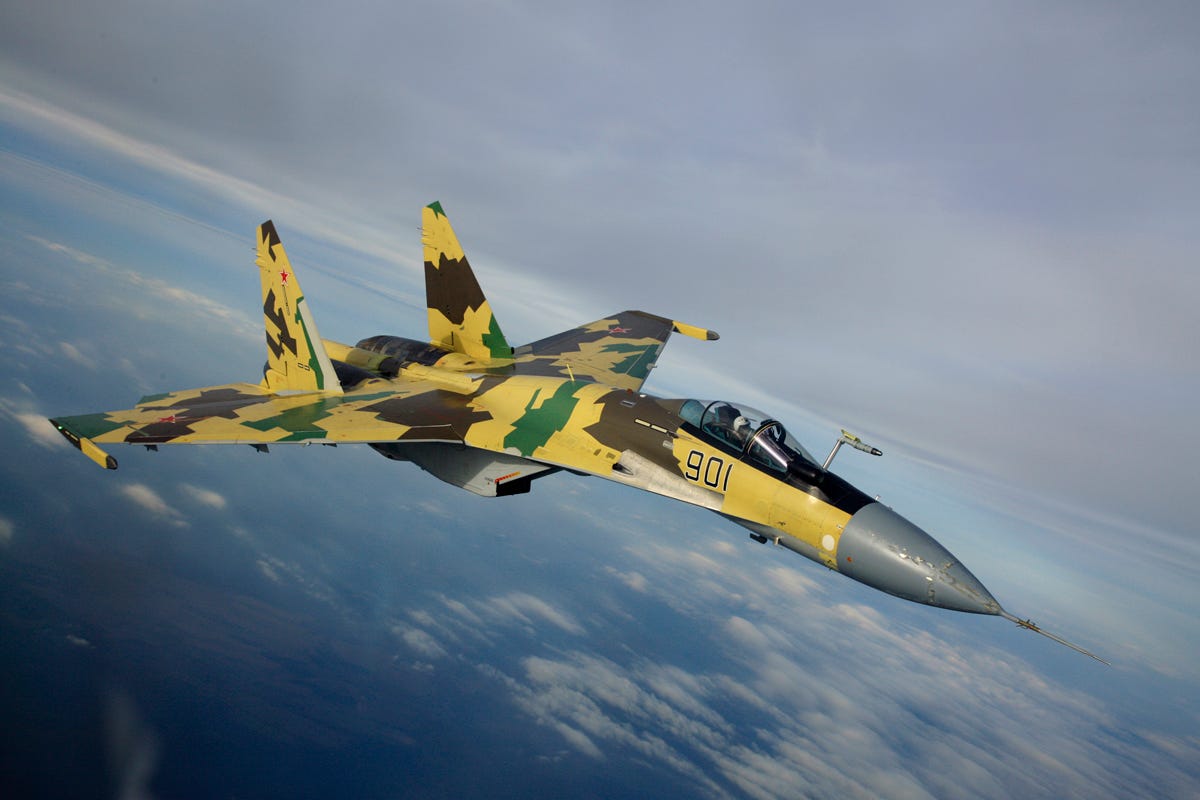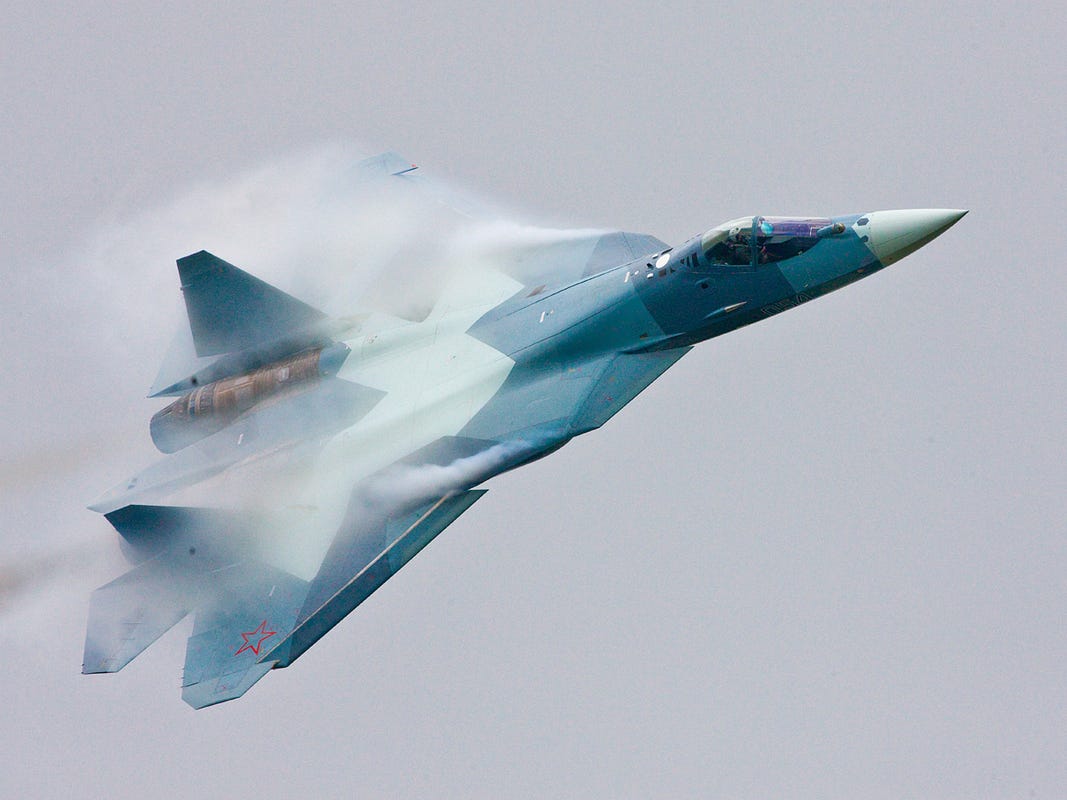Why is Moscow buying three very similar jet fighters?

he Russian air force has just introduced three new jet fighters. Not the much-publicized Sukhoi T-50 stealth fighter—which isn’t ready yet—but three slightly different versions of the classic Su-27, all originating from the same Sukhoi design bureau but built by two separate manufacturers.
Yes, that’s a bit odd—and potentially wasteful. The U.S. Air Force, for one, is buying just a single new fighter type, the F-35 Joint Strike Fighter. The American air arm wants as many as 1,763 copies of the F-35A to replace most of its existing fighters and, in theory, maximize efficiency.
By contrast, Russia is acquiring just a few dozen each of the Su-30M2, Su-30SM and Su-35S—each a different upgrade of the 1970s-vintage Sukhoi Su-27, known to NATO as the “Flanker.” Moscow hasn’t officially explained its jet fighter strategy, but it appears the purchases are meant to keep two factories in business amid a slump in warplane exports.
In any event, Russia’s getting an interesting bunch of highly-capable new jet fighters to begin revamping the country’s geriatric air force, composed mostly of planes built in the 1980s. As development of the stealthy T-50 dominates headlines, the introduction of these three new fighters has passed relatively unnoticed.
The Su-30M2 was the first to join the front-line ranks of the Russian air force—the first in-service photos appearing in December 2011, indicating deployment with the 6972nd Air Base at Krymsk in the southern region of Krasnodar.
The first three examples of the Su-30SM arrived at the 6982nd Air Base at Domna in November 2013. The Siberian base had as many as 10 Su-30SM fighters by the end of that year. A further 10 aircraft should arrive this year, equipping a full aviation regiment.
Meanwhile, this February the first operational Su-35S fighters entered service with the 23rd Fighter Aviation Regiment at the 6883rd Air Base at Dzemgi, in the Khabarovsk Territory in Russia’s Far East.

Su-30M2
First of the new trio to enter operational service, the Su-30M2 is also the least sophisticated. It’s a derivative of the two-seat, multi-role Su-30MKK developed for China by the Komsomolsk-on-Amur Aircraft Production Association, or KnAAPO, based in the Russian Far East.
The Su-30MKK is best understood as an upgrade of the existing two-seat Su-30 interceptor, albeit less sophisticated than the rival Su-30MK made by Irkut. It has provision for in-flight refueling and all-Russian avionics that bestow a multi-role capability, but it lacks the canard foreplanes and thrust-vectoring control engines of the Irkut Su-30MK.
After winning more Chinese orders—this time for the improved Su-30MK2 with anti-shipping capability—KnAAPO subsequently sold derivatives of the Su-30MK2 to Vietnam, Indonesia, Venezuela and Uganda. A key recognition feature of the export Su-30MKK/MK2 and the Su-30M2 for home use are the flat-topped twin tailfins.
The Kremlin placed its initial order for the Su-30M2 in the summer of 2009. These aircraft share much in common with the Su-27SM3, a KnAAPO-built single-seat fighter with improved avionics, but otherwise having more in common with the first-generation Su-27.
The Defense Ministry ordered four Su-30M2s along with 12 Su-27SM3s, and we may presume that the two-seaters are meant to support their single-seat brethren in the combat training and, perhaps, all-weather strike roles.
Orders for the Su-30M2 apparently stand at 20 aircraft, although as of December 2013, only the first four jets have appeared in public.

Su-30SM
Very similar to the Su-30M2 in appearance, the Su-30SM is the product of a different and rival production plant—the Irkut Corporation, based at Irkutsk in Siberia and part of the United Aircraft Corporation that consolidates all of Russia’s private and state-owned plane-makers.
The Su-30SM can best be seen as the Russian version of the Su-30MK, Irkut’s runaway success on the export market that kicked off with sales to India, followed by orders from Malaysia and Algeria.
Compared to the Su-30MKK from KnAAPO, the Su-30MK was always a more capable proposition, incorporating not only a more advanced aerodynamic layout, but also the option of Western avionics. Export customers could take their pick from Russian, Ukrainian, French, Indian and Israeli components.
Hallmarks of the Su-30MK that also appear in the Russian air force’s Su-30SM include two seats, canard foreplanes and thrust-vectoring engines, both allied with a sophisticated fly-by-wire flight control system. Unlike the KnAAPO jets, the Irkut-built Su-30MK and Su-30SM feature distinctive cropped tail fins.
Russia’s Defense Ministry placed a surprise order for the Su-30SM in March 2012. And in December that year the ministry doubled the initial request for 30 aircraft. Reports from the Russian media suggest that all 60 of these jets should be delivered by the end of 2015, although as of December 2013 only 16 aircraft had been handed over.
This February press reports indicted that the Defense Ministry plans to sign additional contracts worth $2 billion for the delivery of 50 more Su-30SMs. Interestingly, some, if not all, of these new fighters could end up in Russian navy service, with the first examples arriving before the end of 2015.
Compared to the export Su-30MKI, the “Russianized” Su-30SM replaces the Indian and Israeli avionics with Russian equivalents. Strangely however, most of the original French avionics—including the head-up display and navigation system—remain.
While the Su-30M2 uses the N001V radar—an evolution of the basic set in the original Su-27—the Su-30SM has the far superior N011M Bars-R with passive electronically scanned array. One unique change compared to the export-optimized Su-30MK relates to the Su-30SM’s ejection seats. These are stronger in order to cope with the heavier weight of Russian pilots.
Although we have yet to see the new-generation Sukhois carrying any truly advanced air-to-air weaponry in air force service, the Su-30SM should be able to launch the new RVV-SD beyond-visual-range missile and the short-range RVV-MD.

Su-35S
The Su-35S differs from the Su-30 family in being a single-seater. While its conceptual lineage traces back to Soviet efforts to improve the Su-27, today’s Su-35 began development in the early 2000s.
In a bid to improve performance and combat capability, the KnAAPO-built Su-35 added a new airframe, avionics outfit and powerplant. The Su-35 includes AL-41F1S engines with thrust vectoring, an advanced fly-by-wire system and new optronic suite. The canard foreplanes are gone, since other aerodynamic refinements are sufficient to achieve super-maneuverability.
While Russia still hasn’t introduced an active electronically scanned array radar—this will likely have to wait until the T-50 is ready—the Su-35S has the next best thing. The centerpiece of the avionics suite is the N135 Irbis, a follow-on to the Bars radar utilizing the same hard-to-detect passive technology.
Like the Russian air force’s Su-30M2 and Su-30SM, the Su-35S was also originally meant as an export fighter, under the Su-35BM designation. The media has linked the Su-35 with a prospective sale to China, although in reality there is next to no evidence of any actual Chinese interest in such a deal.
Instead, Moscow stepped in and ordered the Su-35S version for its own air force in 2009. The Kremlin has received 22 aircraft as of February, 12 of which 12 are now with the first front-line unit at Dzemgi. Delivery of the first batch of 48 Su-35S fighters is likely to end in 2015. Another 48-aircraft order is likely.
With its advanced equipment and capabilities, the Su-35S is perhaps the most realistic interim fighter pending the arrival of the stealthy T-50 in significant numbers. Reportedly capable of carrying the new 200-kilometer-range RVV-BD air-to-air missile, the Su-35S could also prove a viable successor to the Russian air force’s aging fleet of MiG-31 interceptors.

A Russian enigma
Why does the Russian air force need three different variations on the advanced Flanker theme? It would be more efficient to focus on one version, but the fact that rival production centers are responsible for building the fighters complicates Moscow’s calculations.
As long as the Su-30 family was enjoying success on the export market, having two competing airframe-builders was not a problem. As the least capable of the three, the Su-30M2 demonstrates the least potential for future growth. Indeed, there have been suggestions that Russia acquired the Su-30M2 only after airframes became surplus following the collapse of a planned sale to China.
The Su-35 boasts more powerful engines, superior radar and an advanced self-defense suite. On the other hand, the Su-30SM is more readily available, cheaper and has the advantage of two crew members, rendering it suitable for more complex combat missions as well as advanced training.
And now, foreign sales are threatening to dry up entirely. The most significant export operators of the Su-30 series, India and China, are building up their fleets through licensed—in the case of China, unlicensed—production.
Malaysia has elected not to acquire more Su-30MKMs to meet its multi-role combat aircraft requirement and is now mulling a fighter lease option. Additional Indonesian orders are possible to replace veteran F-5s, but will not involve significant numbers.
Moscow has pushed domestic orders for the three different Sukhoi jets more than likely in order to prop up the business of Irkut and KnAAPO. At the same time, bringing these aircraft into Russian service could make them more attractive to foreign buyers. In particular, export sales of the Su-35 have long proved elusive.
Meanwhile, the Russian air force is badly in need of new fighters. The T-50 remains some years from service—and despite the highly positive media reports, there is little objective information on exactly how testing is going with the five flying prototypes.
Unlike with the American F-35, testing of the T-50 taking place outside of public view. But a recent leaked document discovered by long-term Russian aviation observer Piotr Butowski suggests that significant design revisions might be in the works.
The T-50’s schedule has stretched farther and farther to the right. Originally planned for handover to the air force’s Akhtubinsk flight test center for evaluation in 2014, recent announcements suggest this might now slip until the second half of 2016. This would derail plans to declare initial operational capability, and the start of full-scale production, at the end of 2016.
The best-case scenario would have seen 60 production T-50s delivered between 2016 and 2020, but this now seems a distant hope. As a result, the air force is badly in need of supplementary equipment.
Of the many hundreds of front-line fighters in Russian air force service, most are now seriously showing their age. The collapse of the Soviet Union and subsequent economic crisis reduced production of combat aircraft to a trickle. Only in recent years has Moscow had the resources to buy meaningful numbers of new jets.
But while the three new Flankers represent a considerable advance in capabilities compared to their predecessors, the recent orders are still inadequate to wholly revamp the Russian air force. Even with dozens of new Su-30M2s, Su-30SMs and Su-35Ss, the Kremlin’s fighter fleet is simply too old.
The MiG-29, a lightweight complement to the Su-27, is in service in dwindling numbers, the most advanced examples being a single regiment of hand-me-down MiG-29SMTs rejected by Algeria. Heavyweight MiG-31s still occupy six front-line bases, but only a limited number have been upgraded to MiG-31BM standard—and there is no evidence that these have received their promised advanced new weapons.
With a planned upgrade for the MiG-29s having evaporated, and with a dedicated successor to the MiG-31 looking increasingly unlikely, it seems that the various products of the Sukhoi design bureau will have to defend Russian skies over the long term.
Whether Moscow will keep buying the Su-30M2, Su-30SM and Su-35 at the same time remains to be seen. Russia’s jet fighter future rests heavily on the fortunes of the T-50 project.war-is-boring
No comments:
Post a Comment